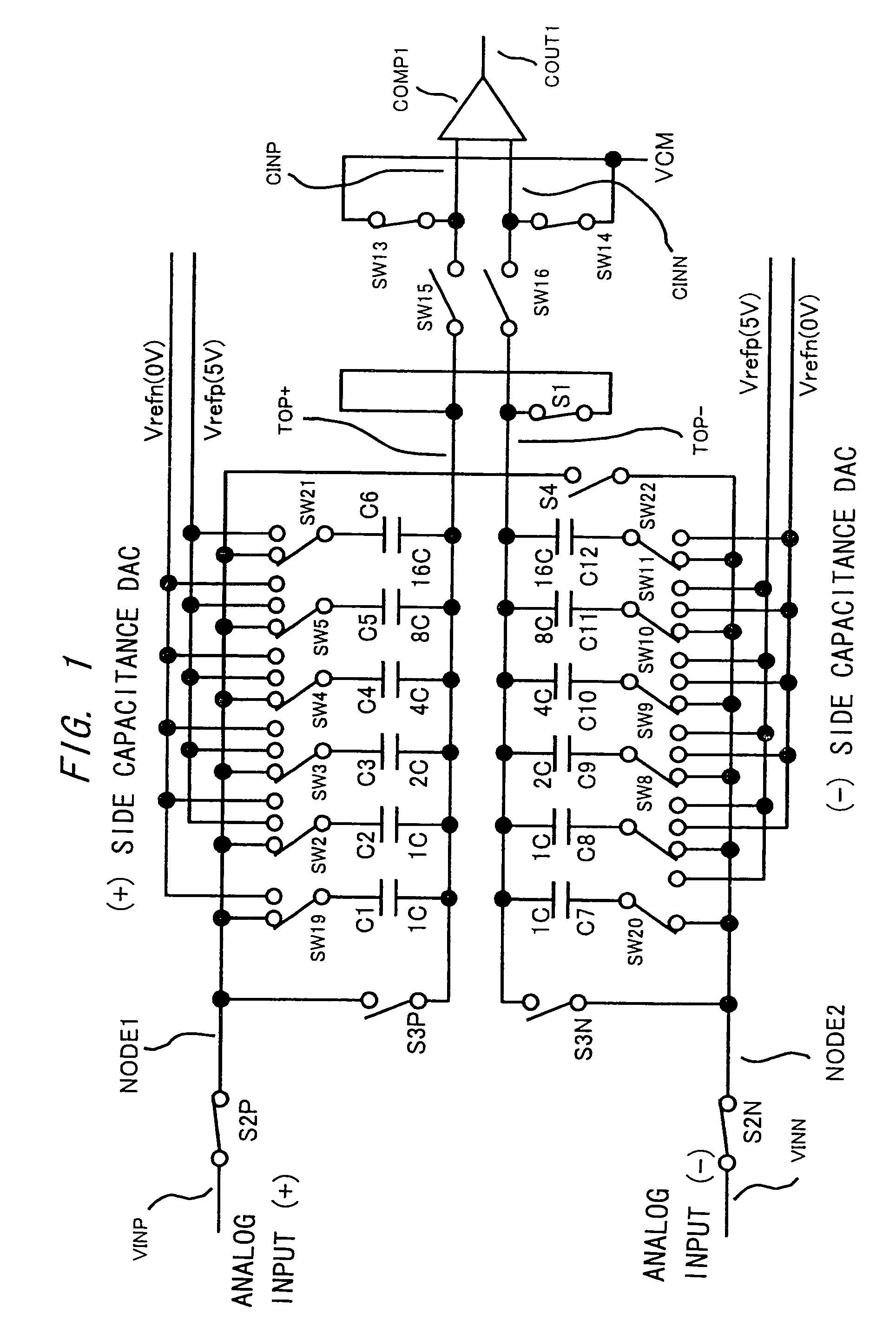Analog-to-digital converter
a converter and analog technology, applied in the direction of digital-analogue converters, instruments, cleaning using liquids, etc., can solve the problems of increasing the cost of the converter, requiring further speed-up, and reducing the cost performance, so as to achieve the effect of small area and low power
- Summary
- Abstract
- Description
- Claims
- Application Information
AI Technical Summary
Benefits of technology
Problems solved by technology
Method used
Image
Examples
first embodiment
[0115]A first embodiment of the invention will hereinafter be explained in detail. FIG. 1 is a circuit diagram showing an AD converter according to the first embodiment of the invention. FIG. 2 is a diagram showing a control timing of the switches S1, S2P, S2N, S3P, S3N and S4 in FIG. 1.
[0116]In FIG. 1, SW2 through SW5, SW8 through SW11, SW13 through SW16, SW19 through SW22, S1, S2P, S2N, S3P, S3N and S4 represent switches, C1 through C12 designate capacitances, VINP indicates a (+) analog input, VINN denotes a (−) analog input, TOP+ designates a (+) side top plate of a capacitance array, TOP− represents a (−) side top plate of the capacitance array, Vrefp is a (+) side reference electric potential (e.g., 5V), Vrefn is a (−) side reference electric potential (e.g., 0V), COMP1 stands for a comparator, CINP and CINN are comparator inputs, COUT1 is an output of the comparator, VCM is a bias potential (e.g., 2.5V) of the comparator input when sampling, NODE1 and NODE2 represent internal...
second embodiment
[0164]The AD converter according to a second embodiment of the invention will be described with reference to FIG. 4. In the first embodiment, after switching OFF the switch S2P for connecting the (+) side analog input to NODE1 and the switch S2N for connecting the (−) side analog input VINN to NODE2, the fluctuations of the electric potentials of NODE1 and NODE2 are restrained by switching ON the switch S4 that equalizes the electric potentials of NODE1 and NODE2.
[0165]The second embodiment will exemplify an electric potential fluctuation restraining means that restrains the fluctuation of the electric potentials of NODE1 and NODE2 in addition to the operation of this switch S4. Alternatively, the electric potential fluctuation restraining means in the second embodiment will be exemplified as a substitute for the operation of the switch S4. In the second embodiment also, when finishing the sampling, the switches S2P, S2N for supplying the analog input signals VINP, VINN to the botto...
third embodiment
[0187]FIGS. 5 and 6 are circuit diagrams each showing an AD converter according to a third embodiment of the invention. In FIG. 5, SW2 through SW5, SW8 through SW11, SW13 through SW16, SW19 through SW22, S1, S2P, S2N, S3P, S3N and S4 represent switches, C1 through C12 designate capacitances, VINP indicates a (+) analog input, VINN denotes a (−) analog input, TOP+ designates a (+) side top plate of a capacitance array, TOP− represents a (−) side top plate of the capacitance array, Vrefp is a (+) side reference electric potential (e.g., 5V), Vrefn is a (−) side reference electric potential (e.g., 0V), COMP1 stands for a comparator, CINP and CINN are comparator inputs, COUT1 is an output of the comparator, VCM is a bias potential of the comparator input when sampling, NODE1 and NODE2 represent internal nodes, a (+) side capacitance DAC represents DAC constructed of a capacitance array of C1 through C6, and a (−) side capacitance DAC designates DAC constructed of a capacitance array of ...
PUM
 Login to View More
Login to View More Abstract
Description
Claims
Application Information
 Login to View More
Login to View More - R&D
- Intellectual Property
- Life Sciences
- Materials
- Tech Scout
- Unparalleled Data Quality
- Higher Quality Content
- 60% Fewer Hallucinations
Browse by: Latest US Patents, China's latest patents, Technical Efficacy Thesaurus, Application Domain, Technology Topic, Popular Technical Reports.
© 2025 PatSnap. All rights reserved.Legal|Privacy policy|Modern Slavery Act Transparency Statement|Sitemap|About US| Contact US: help@patsnap.com



